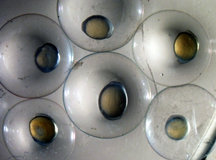Invasive Asian carp may be able to spread further than once thought
March 19, 2013
 |
|
A
collection of carp eggs collected by Goforth's team. (Photo provided by Reuben
Goforth)
|
WEST LAFAYETTE, Ind. – Those concerned about the spread of Asian carp in Midwest rivers had some comfort in the expectation that varieties of these invasive fish could only invade a restricted range of river conditions - until now.
A Purdue University study shows that Asian carp are spawning in waters generally thought too narrow or slow moving. And while spawning was thought to end sometime in July, researchers have found evidence of fish spawning far upstream and eggs drifting in water as late as September in the Wabash River in Indiana.
"It looks like the carp can probably become established in a wider range of environmental conditions than once thought," said Reuben Goforth, an assistant professor of forestry and natural resources. "While the presence of eggs indicates successful spawning by these fishes in new areas, it's not known yet whether those eggs would be successful in surviving to adulthood."
 |
|
Reuben
Goforth
|
Silver carp, black carp, grass carp and bighead carp - known collectively as Asian carp - are spreading throughout Midwest rivers. These invasive species may be outcompeting native species that are commercially and recreationally desirable. The fish can weigh up to 60 pounds, and silver carp jump out of water when disturbed, sometimes causing injuries to boaters and others using rivers and streams.
While conservation workers and scientists are working hard to contain Asian carp, there is still concern that they could spread to other tributaries if they get into the Great Lakes.
Models used to predict where and when Asian carp might spawn have been heavily based on information gathered from native habitats in Asian rivers and streams. But Goforth said there is strong evidence that the carp are able to reproduce in waters and conditions that were not expected.
"The reason truly invasive species are so successful is because they overcome obstacles," Goforth said. "When you base their limitations on what happens in their native ecosystems, it's a good start. But it may be a good idea to go back and take this new data to recalculate more precise limits based on these new understandings."
Goforth said it had been believed that heavier spring rain that increased water depth and flow in rivers was necessary for successful spawning. But last year's severe drought limited stream flows, and Asian carp eggs were found in shallow and narrow portions of the Wabash River once thought incapable of supporting the species.
"We didn't have the normal spring floods and they spawned anyway," Goforth said. "Those changes in water flow and depth might be a cue to spawn, but they're not something that's absolutely necessary."
Goforth said his laboratory would work on determining what allows Asian carp to adapt to conditions unlike those in their native habitats.
"What we don't know is whether they have the ability to acclimate to those conditions or whether there is a sort of micro-evolution going on that allows them to adapt to these conditions," he said.
The Indiana Department of Natural Resources and the U.S. Geological Survey's Upper Midwest Environmental Sciences Center collaborated with Purdue researchers. Their findings were published in the journal Freshwater Biology.
The Indiana DNR, U.S. Environmental Protection Agency and Great Lakes Restoration Initiative funded the research.
Writer: Brian Wallheimer, 765-496-2050, bwallhei@purdue.edu
Source: Reuben Goforth, 269-967-7620, rgoforth@purdue.edu
ABSTRACT
Phenotypic Plasticity in the Spawning Traits of Bigheaded Carp (Hypophthalmichthys spp) in Novel Ecosystems
Alison A. Coulter, Doug Keller, Jon J. Amberg, Elizabeth J. Bailey and Reuben R. Goforth
1. Bigheaded carp, including both silver (Hypophthalmichthys molitrix) and bighead (H. nobilis) carp, are successful invasive fishes that threaten global freshwater biodiversity. High phenotypic plasticity probably contributes to their success in novel ecosystems, although evidence of plasticity in several spawning traits has hitherto been largely anecdotal or speculative.
2. We collected drifting eggs from a Midwestern USA river from June to September 2011 and from April to June 2012 to investigate the spawning traits of bigheaded carp in novel ecosystems.
3. Unlike reports from the native range, the presence of drifting bigheaded carp eggs was not related to changes in hydrological regime or mean daily water temperature. Bigheaded carp also exhibited protracted spawning, since we found drifting eggs throughout the summer and as late as 1 September 2011. Finally, we detected bigheaded carp eggs in a river reach where the channel is c. 30 m wide with a catchment area of 4579 km2, the smallest stream in which spawning has yet been documented.
4. Taken with previous observations of spawning traits that depart from those observed within the native ranges of both bighead and silver carp, our findings provide direct evidence that bigheaded carp exhibit plastic spawning traits in novel ecosystems that may facilitate invasion and establishment in a wider range of river conditions than previously envisaged.
Ag Communications: (765) 494-2722;
Keith Robinson, robins89@purdue.edu
Agriculture News Page

